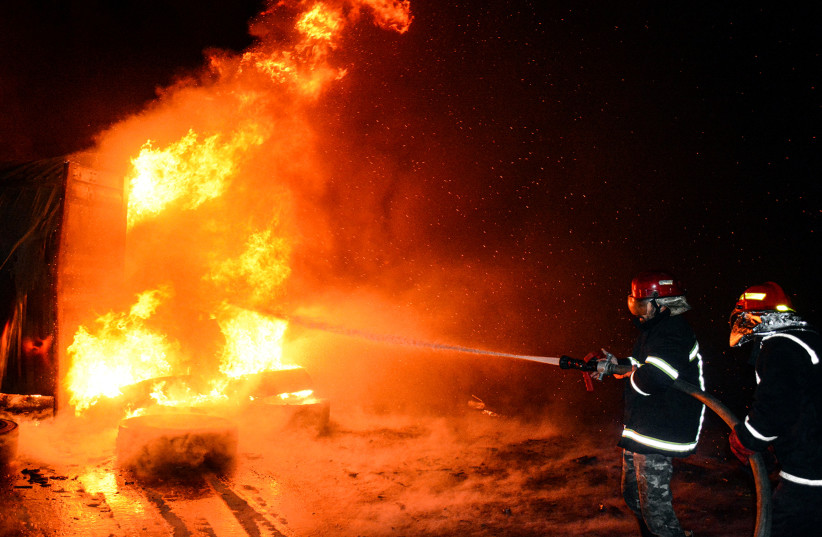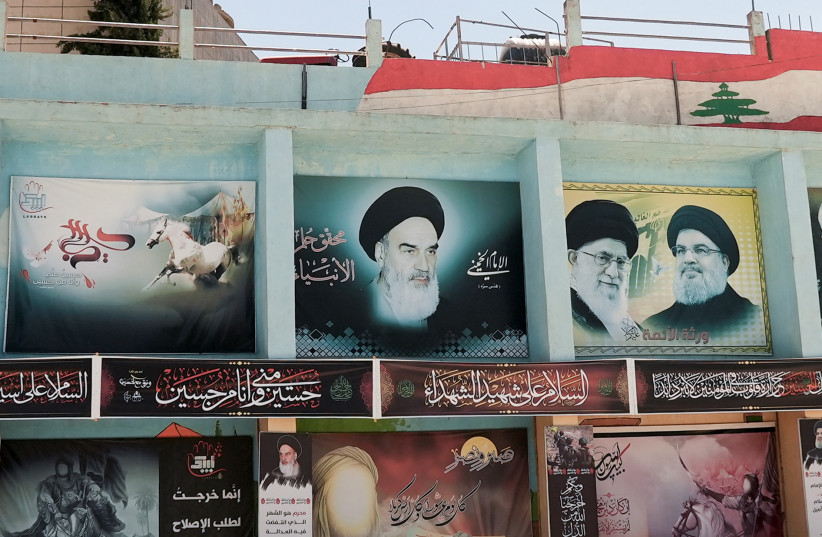It’s a campaign that the IDF believes would force Iran and its proxies out of Syria; a campaign full of operations in which Israel would not take responsibility and would push off wars to the far future.
The targets that the campaign has hit almost weekly in recent months are specific and sometimes strategic. They all belong to Iran or its proxies, such as Hezbollah. And the targets are all identified by IDF soldiers who work 24/7 in small rooms in Central Israel before they are brought to the IDF chief of staff and defense minister, who give the green light to the pilots to strike.
Israel’s war-between-wars strategy (MABAM in Hebrew) was the brainchild of then-defense minister Boogie (Moshe) Yaalon and then-chief of staff (ret.) Benny Gantz. Thousands of soldiers and officers, from elite ground forces to intelligence personnel, operations staff and pilots, have taken part in the MABAM, which will mark its 10th anniversary this year.
In a recent interview in Maariv, Director-General of the Defense Ministry Maj.-Gen.(ret.) Amir Eshel recounted the first strike of the MABAM when he was just six months into his position as head of the Israel Air Force.
“The order came at the beginning of January, and the attack took place on January 30, 2013. We struck an entire battalion of SA-17 surface-to-air missile batteries that the Syrians bought, with Hezbollah funding, and were about to transfer to [Hezbollah Secretary General Hassan] Nasrallah. We destroyed them all.”
Israeli Defense Ministry Director-General Maj.-Gen. (ret.) Amir Eshel
“The order came at the beginning of January, and the attack took place on January 30, 2013,” he said. “We struck an entire battalion of SA-17 surface-to-air missile batteries that the Syrians bought, with Hezbollah funding, and were about to transfer to [Hezbollah Secretary General Hassan] Nasrallah. We destroyed them all.”

Eshel explained that the shipment of missiles that could pose a threat to the IAF came from Russia and landed in Syria’s Tartus port before making its way to Damascus en route to Lebanon. “We monitored every step,” Eshel said.
Though there were some who were against striking the missiles, in the end the IAF carried out the strike “and completely destroyed them,” he said.
The missiles would have “completely changed the IAF’s superiority in the region.”
The MABAM has been an ongoing campaign in the air, on land and sea, as well as cyber-kinetically, according to foreign reports. The aim is to thwart Tehran’s aspirations of regional hegemony and curtail the smuggling of advanced weaponry to Hezbollah in Lebanon from Iran.
IDF intelligence in the war-between-wars
The IDF’s Military Intelligence Directorate (AMAN) is a key player in the MABAM; its main mission is to supply the government and military with accurate and timely alerts to protect the country from any threat it may face.
The directorate has three main units – 8200, 9900 and 504 – with the IDF’s Unit 8200 as the main information gathering unit. Troops develop tools to analyze, process and share the intelligence with all relevant authorities.
Along with these three units, troops from the directorate’s research division spend countless hours gathering intelligence to prepare targets in order for them to be approved by the General Staff and political echelon.
With the majority of operations remaining behind closed doors, the display of talent and creativity of the troops involved in the MABAM usually goes unnoticed – until the foreign media reports on airstrikes in Syria.
The Magazine had the rare opportunity to meet with several troops in the research division, who find the targets and provide accurate intelligence to decision-makers.
UNTIL A few years ago, the research division focused on the general situation in the region and how it impacted Israel. Recently, however, it shifted its focus to analyzing the region’s immediate impact on Israel’s security situation.
The research division is comprised of a small team responsible for gathering targets. Using various means such as human intelligence (HUMINT), visual intelligence (VISINT) and big data, they can find dozens of new targets daily. But with mountains of data available to them, the challenge is to take the information gathered, look at what’s relevant, and turn it into a target.

It’s not only about identifying a target, but knowing exactly where it is, such as what part of a room, on what floor, of which building. Or which truck in which convoy, or what container in what warehouse, in which section of a busy international airport.
Once a target is found, there are bureaucratic steps required in order to get the clearance to make it a target, as well as the operational steps necessary to destroy it.
And there are thousands of these targets in Lebanon and Syria.
By using the research division troops alongside innovative intelligence and advanced technology, the IDF’s target bank in the Northern Command is 20 times larger than the target bank the military had the last time it went to war with Hezbollah in 2006. Thousands of targets are ready to be attacked, such as headquarters, strategic assets and weapons storehouses.
The military divides its targets into four groups: targets of the enemy’s power; targets of quality; targets that allow the enemy to continue fighting, such as infrastructure; and real-time targets.
Some targets can be urgent, moving targets that need to be destroyed in several hours, while others can take weeks before they are struck.
One such target was identified by the unit after they received intelligence on precision weapons that Iran was attempting to smuggle via Syria. However, the intelligence wasn’t clear; the IDF did not know how Iran was going to move the weapons. Was it by air? Or by a convoy on the ground?
The troops worked on the intelligence around the clock in order to get a clearer picture of what exactly was coming in and how. But then they had another challenge: how to best destroy it.
Working alongside other units in Military Intelligence, data units and operational teams in the IAF, they were able to put together a detailed and precision strike plan. The troops from the research division that first identified the target were in the IDF’s operational war room (known as the Bor, or pit) when the strike took place.
PRIVATE D was drafted into the IDF after moving to Israel from Amsterdam last year. She told the Magazine that she had always wanted to serve in Military Intelligence but found it a challenge, since she wasn’t fluent in Hebrew.
D, whose name cannot be published for security reasons, explained that she was always interested in the Middle East before moving to Israel. She began her service at Mikve Alon, where she learned Hebrew and heard about the Li-Am project that allows new immigrants to serve in the Intelligence Directorate.
“You imagine being in intelligence, but you can really only understand what it’s about once you are in it,” D said.
She explained that she and her fellow soldiers “know more or less what we are looking for” when they are searching for targets. But, “every target is different, and we need to have a lot of creativity and use all the tools available and the knowledge we have of the area.”
Due to the classified nature of her job, D’s family does not know what she does in the IDF.
“The fact that I don’t live with them makes it a bit easier, but sometimes it’s upsetting that you can’t talk about it,” she said. “It’s extremely rewarding to know the impact of my role. It’s an honor to serve in this position; it’s really special.”
Corporal A moved to Israel from the US three years ago after going on the March of the Living, the annual educational program that brings students from around the world to Poland and Israel to learn about the Holocaust.
Like D, she got into her position after hearing about Li-Am at Mikve Alon.
“When you are outside AMAN, you don’t really know what it’s all about,” she said. “If someone would have told me that I would be in the Bor and see my target blown up, I would have told them that they were crazy.”
While D’s family remains in Europe, A’s family also moved to Israel, making it hard to not share what she is taking part in.
“I go home and I can tell them that something happened, but I can’t tell them what,” she said, adding that “knowing the impact [of MABAM] on our security is insane.”

IRAN HAS been one of the Syrian regime’s main allies in the war that has ravaged Syria since 2011, sending thousands of militia fighters and equipment to the war-torn country. Iran continues to insist that it is in Syria as a guest of Damascus and would only leave at its request.
According to a senior IDF officer, MABAM led to a strategic change in the region and destroyed the vision of Qasem Soleimani, the former Islamic Revolutionary Guard Corps Quds Force major-general, who was killed in an American airstrike in Baghdad in 2020.
Part of Soleimani’s plan was to establish missile bases, anti-aircraft and intelligence bases, as well as establish a force similar to Hezbollah in Syria. While the MABAM hasn’t succeeded in removing Iran completely from the area, it has been able to achieve a majority of objectives set by the military.
Following Soleimani’s death, there has been a clear change in Iran’s operations in Syria. His replacement, Ismail Ghaani, is far from the charismatic leader that Soleimani was. Although he is able to lead the IRGC force, he does not have the same abilities as Soleimani.
Nevertheless, Iran continues to send weapons to Syria, as well as officers with training and knowledge.
There have been various reports of Iranian forces and their proxies withdrawing from Iran, most recently in mid-September, due to the success of Israel’s MABAM. According to sources, 90% of the weapons that Iran wanted to smuggle into Syria have been destroyed by Israeli operations.
Not only have the strikes in Syria destroyed an immeasurable amount of advanced and strategic weaponry, but Iran’s air, land and sea corridors didn’t function for 70% of 2021 due to operations carried out as part of the MABAM.
Last year, IDF Chief of Staff Lt.-Gen. Aviv Kohavi said that the increase in operations – both overt and clandestine – had led to a slowdown of Iran’s entrenchment in Syria. “But we still have a long way to go to complete our goals in this arena,” he said.
THE WORK carried out by the team has led to the MABAM being one of the most surgical offensives ever.
According to a January report by Airwars, which tracks all civilian harm by all foreign actors in Syria since 2014, less than 50 civilians have been killed in Syria since Israel began its campaign targeting Iranian military infrastructure and proxies.
Meanwhile, local Syrian reporting found that over 600 militants, as well as Syrian and Iranian troops, have been killed between January 2013 and October 2021.
The rate of civilian casualties in strikes by the IAF was by far the lowest compared to other foreign actors in the beleaguered country, with thousands of civilians killed by Russia and the US-led coalition.
According to the findings of Airwars, Russia is “likely responsible” for at least 4,096 to 6,085 civilian deaths since 2015; the US-led coalition is “likely responsible” for 5,724 to 9,432 civilian deaths in Syria.
